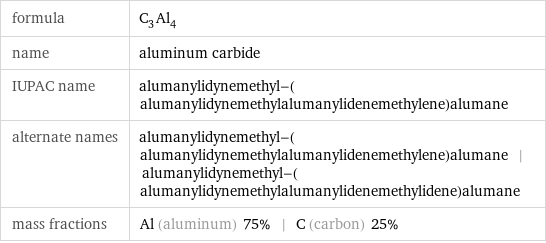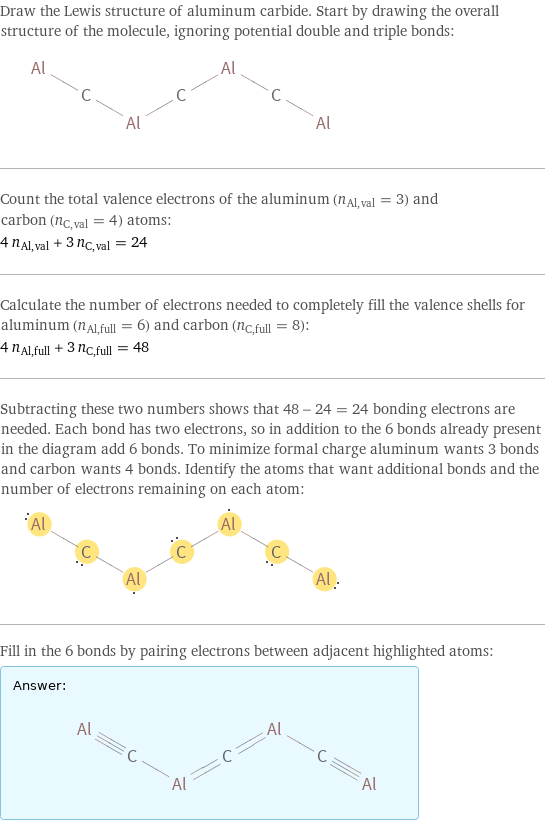Input interpretation

aluminum carbide
Chemical names and formulas

formula | C_3Al_4 name | aluminum carbide IUPAC name | alumanylidynemethyl-(alumanylidynemethylalumanylidenemethylene)alumane alternate names | alumanylidynemethyl-(alumanylidynemethylalumanylidenemethylene)alumane | alumanylidynemethyl-(alumanylidynemethylalumanylidenemethylidene)alumane mass fractions | Al (aluminum) 75% | C (carbon) 25%
Lewis structure

Draw the Lewis structure of aluminum carbide. Start by drawing the overall structure of the molecule, ignoring potential double and triple bonds: Count the total valence electrons of the aluminum (n_Al, val = 3) and carbon (n_C, val = 4) atoms: 4 n_Al, val + 3 n_C, val = 24 Calculate the number of electrons needed to completely fill the valence shells for aluminum (n_Al, full = 6) and carbon (n_C, full = 8): 4 n_Al, full + 3 n_C, full = 48 Subtracting these two numbers shows that 48 - 24 = 24 bonding electrons are needed. Each bond has two electrons, so in addition to the 6 bonds already present in the diagram add 6 bonds. To minimize formal charge aluminum wants 3 bonds and carbon wants 4 bonds. Identify the atoms that want additional bonds and the number of electrons remaining on each atom: Fill in the 6 bonds by pairing electrons between adjacent highlighted atoms: Answer: | |
Basic properties

molar mass | 143.959 g/mol density | 2.36 g/cm^3
Units

Chemical identifiers
![CAS number | 1299-86-1 PubChem CID number | 16685054 PubChem SID number | 24854497 SMILES identifier | C(#[Al])[Al]=C=[Al]C#[Al] InChI identifier | InChI=1/3C.4Al/rC3Al4/c4-1-6-3-7-2-5 MDL number | MFCD00003425](../image_source/80c51552ef67b6792f1aaa55be416db7.png)
CAS number | 1299-86-1 PubChem CID number | 16685054 PubChem SID number | 24854497 SMILES identifier | C(#[Al])[Al]=C=[Al]C#[Al] InChI identifier | InChI=1/3C.4Al/rC3Al4/c4-1-6-3-7-2-5 MDL number | MFCD00003425
Toxicity properties

odor | odorless